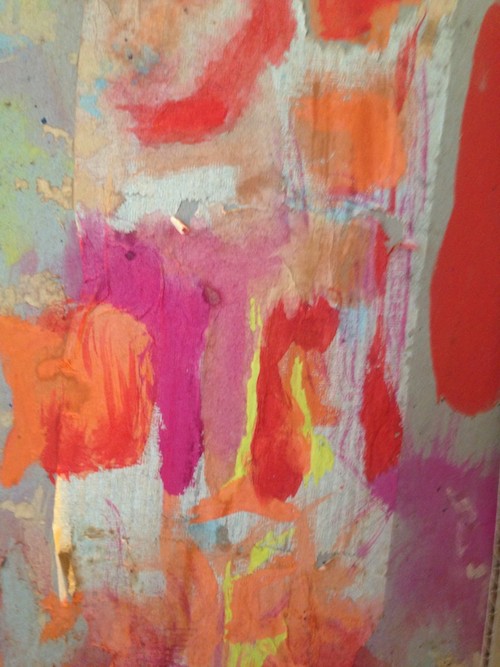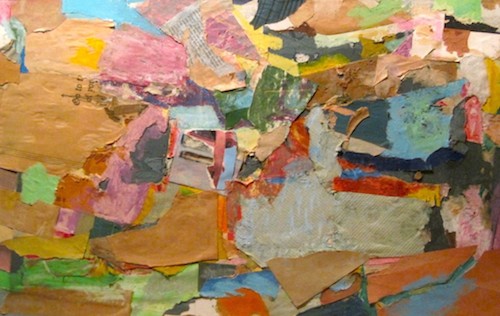
Over dinner last night with Paule Anglim I realized this was the perfect time to ask about Robert Duncan as a visual artist. As many of you know, Paule Anglim is a San Francisco gallerist who represented Jess in San Francisco for many years, but she tells me she met Duncan first. (There is a fair amount about Anglim’s dealings with the poets of the 1960s in the Irish poet John Montague’s memoirs of his years in Berkeley—roughly the hippie era. The book is called, The Pear is Ripe.) We were having sole with tiny new potatoes and asparagus dressed in tartar sauce. I explained to her that, just as I live with a superior artist, I can recognize that a certain dose of competition in the household—and we know that Duncan and Jess had made the household into a fetish, that “domestic scenes” were, in some sense, the theme of much of Duncan’s work, anyhow, I asked her, what was Duncan’s feeling about his own work in visual art, knowing that his boyfriend was the greater artist by far. I hate feeling like second best in a relationship, and I can’t imagine Duncan taking to it either. Paule raised a glass to her lips, then lowered it to the white tablecloth. “Do you know,” she said, “he never betrayed by word or gesture, any sign he wasn’t as talented as Jess. Possibly it never entered his head.” She pointed out that not only did Duncan make drawings, but Jess wrote many poems and both of them encouraged each other.
I described the one painting recently exhibited at the Mythos Gallery in North Berkeley, Christopher Wagstaff had explained to a group of us at the gallery that only a handful of Duncan paintings survive, and that this one, painted on toilet paper in the 1950s. People giggled of course. The result couldn’t have better illustrated Rebecca Solnit’s thesis that the Bay Area artists of the Cold War purposely employed degraded, impermeable materials to illustrate their belief that art is not so much a product but a process and a project, one in which market structures play little part. People in California were living in the apocalyptic shadow presaged by the explosions of the atom bombs on Nagasaki and Hiroshima. The legend is that Jess worked on the Manhattan Project—Bern Porter too? In any case with the Oppenheimer legend so firmly rooted in the Bay Area there was much reason here to live for today, as Duncan seemed prepared to do in his sexual life. And there was not much reason to reach for the oil paint nor for canvas, not when toilet paper, the simple, universally comical fabric, was right within reach in every properly maintained domestic arbor.
The painters and artists who showed in San Francisco galleries in the mid to late 1950s had been resistant to the totalizing moves of the art market, pressures which ordained a particular sort of expressionism, —the abstract kind—as the only viable form of plastic art sponsored by the government. Obviously Duncan and Harry Jacobus were watching the revolution from the far side and, just as Duncan puzzled some critics by declaring himself a “derivative” poet, almost as if he didn’t seem to understand that “derivative” isn’t a good thing, he seems in his art work to turn back to older models. To the Impressionists, to the Fauve movement, to Cubism, to Arts and Crafts—but his work seems eerily modern perhaps due to its DIY nature. That toilet paper painting for example, In an extreme example of figure/ground tension, I imagine only the oil paint actually preserves the material, gives it a second life. But in the Cold War, dissolution and escape were everything. Afterwards in a discussion, I was challenged to posit a framework for discussing this romantic work outside of the tired old “abstract expressionism” versus everything else dichotomy. Think not in nouns but in gerunds, I was told. “What was opening when this work was made? What was closing?” If it was Duncan, I said brightly, I could mention The Opening of the Field.
And there are texts buried in it, internal evidence of the contemporaneity of the work for, after all, the “turn to language” was working not only in New York but everywhere in the world after a certain date (Liz Kotz implies 1952 in her wonderful book about minimal and conceptual art practices and their various hookups with the written and sonic word, Words to be Looked At). Here I think not only of Duncan and Jess, but of Bill Brodecky’s giant recreations of Nancy Drew book jackets, of Fran Herndon’s big painting “Opening Day” in which the words of Willie Mays, “I don’t count ‘em, I just catch ‘em” drift like clouds over the ballpark, I think of Jess, his Tricky Cad balloons, his paste-ups and translations in general, I think of David Young Allen’s picture he showed at Mythos Gallery last year with the name of Pauline Kael embossed on it like a tattoo. Or in George Stanley’s collage from the same period, about which I have written extensively in The Capilano Review tribute to Stanley issue, and about which I wrote, “the various printed matter in Stanley’s picture has been varnished to the point of no recovery—a point of reading without recognition. It’s not only flat paper here, but corrugated and patterned papers, paper tape you’d unroll to pack up a parcel with, torn color postcards of colorful city life, rugged paper towel saturated in pale blue ink, tiny, tiny fragments, some smaller than an aspirin. Lots of neutrals. It was as if only an inventive and rebellious mind could paint a picture out of such nebulous pleasures.”

Poet, novelist, playwright, art critic, and scholar Kevin Killian earned a BA at Fordham University ...
Read Full Biography

